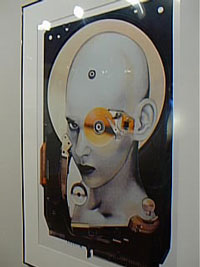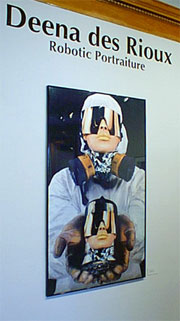Deena des
Rioux: High Tech Messenger
Interview by Michael R. Evans
The old and new mix it up at the Hockaday Fine
Arts Museum
302 2nd Ave. East in Kalispell, Montana. The former Carnegie Library
building (pictured from the outside) is currently hosting Deena
des Rioux’s travelling exhibit of computer- generated portraits.
There's also “traditional” items from the permanent collection,
and “mythological” graphics by Michael C. Spafford plus stoneware
pottery by Robert Markle. “The Hockaday” is open Wednesdays through
Saturdays from 11 to 5 (8 PM on Wed.and Fri.) plus free admission
on Wednesdays.
“This thing with digital photos is a hands-off medium,”
says Deena des Rioux from her home in New York City.
The Hockaday Fine Arts Museum, south of the Kalispell Public
Library, is showing a collection of her large computer-generated
images called “Robot Portraiture which runs until May 27, 2000.
Ms. Des Rioux (pronounced: day-ree-YOU) will visit Kalispell
for a special reception on May 5.
I used to be a painter, with acrylics.” she says, “I would set
up the canvas using Liquitex medium, then I’d paint over the cross-hatching!”
She laughs about the contrast between her tactile early
work and the machine-fine smoothness of her present work. “I started
this digital stuff in 1989” she continues, “I used to physically
cut things up, and build layers. You HAD to use a scanner
in those days!”
“For the last four or five years, she adds, I’ve been able to
cut and paste using the computer only – there’s no hands-on cutting.”
Deena still has her own Canon copier. “For black and white sketches,”
"My current working method uses a scanner, a PC computer, and
the Photoshop 5.5 program to manipulate the scanned-in camera-based
visual items." she says, "The photographic output is lab-processed
from CD files." She also states,"Its not visitor-friendly at the
lab. I rarely go there."
The Hockaday exhibit exemplifies tension between ‘old’ and ‘new’
aesthetics. The turn-of-the century building, with its hardwood
floors and oaken trim, has a squared-circular layout under it’s
old domed roof. As the viewer spirals around the museum, images
inspired by ancient Greece, lithos of Missouri River headwaters,
and a bronze statuette of a Native American mix together with
two rooms devoted to colorful graphics of “future humans,” integrated
with electronic circuitry, wires, and mechanics.
An
androgynous, bald-headed humanoid/disk drive hybridized creature
gazes at the gallery-stroller. The title card reads “Esther:
Bionic Punk.”
|
 |
“Oh Esther – she’s a friend of mine!” says des Rioux, (as if
knowing cyborgs was a common occurance) “Do you want to know her
last name? Grillo -- Esther Grillo, she does futuristic, tortured
sculpture! (It’s not surprising to know that Esther is all-human,
after all.) “I did that portrait from my head, and showed it to
her in New York when it was first exhibited. I took a picture
of her standing next to it! She was really pleased.”
“All my life I wanted to do science-fiction,” Deena emphatically states,
“My work is all over it, and about it! When I was a little girl I read
the Boston Globe, and this article in “Parade Magazine” about the fading
and extinction of our sun. It kind of scared me -- but it also had these
PICTURES showing future humans, with no hair and toes and things! We know
now that it would take intervention to do this.”
Both of her parents were New England landscape artists, Sam and Sophina
G. Coty. They ran their own gallery in Rockport, Massachusetts. Deena grew
up studying the fine arts, going to the Rhode Island School of Design,
and Le Sorbonne in Paris, France. (Where she met her husband, Philippe.)
“My influences were still “The Twilight Zone,” Ray Bradbury, the “Time
Machine” movie, and a book by Ayn Rand called “Anthem,” says des Rioux.
“Silicon Ingot” more than any other of my pieces, is about being a
precursor to our genetic intervention. (It’s also the largest picture in
the show.) The Asian imagery I sometimes use is a deliberate reference to high-tech
themes, but we’re all in it together! 'Wafer-Scale Integration' utilizes
African decorative arts, as well as being a portrait of an African person."
The Asian imagery I sometimes use is a deliberate reference to high-tech
themes, but we’re all in it together! 'Wafer-Scale Integration' utilizes
African decorative arts, as well as being a portrait of an African person."
She’s currently expanding her imagery by putting whole figures and
machinery together. “They’re more ‘covert,’ The portraits were obviously
about faces.” des Rioux says, “The new pieces have more emphasis on the
equality of the components and the human element – they’re so matched,
they become one.
“I see myself as some kind of messenger – to intervene to make
things that propel more to discovery and creativity, and eliminate divisiveness
by combining high-tech with the human.” Deena says, “A mode where the world
can accept this kind of change.”
She’s looking forward to her visit on the first Friday in May, and
expresses excitement about meeting the students from FVCC. “Community colleges
are surprising.” she says, “They cut right through it. At Nassau Community
College I saw everybody from kids, to people in their eighties. Life is
EVERYBODY! Its not real life if the only people you meet are in your own
age group.”
“At the Hockaday, I’ll be ‘wired for sound,’ and be walking around,
connecting with people as they come in, but everyone will be able to hear
me.
Deena welcomes email: artpixel@hotmail.com |
